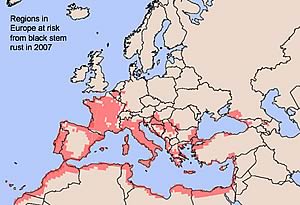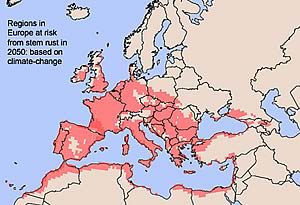 |
|||||||||
|
|||||||||||||||||||
|
|
Crops,
Climate Change and Computers 19/04/07 A new race of a disease called black stem rust, caused by the fungus Puccinia graminis, is on the move and posing a threat to many of the world’s wheat growing regions. Although not a threat to UK wheat crops today, scientists at SAC are looking to the future and assessing what the scene could be by 2050.
Using a specially developed computer model the researchers are predicting how certain crop diseases, not previously seen in the UK, may spread in the future as a result of climate change. This surveillance of threats from new diseases provides an opportunity for crop scientists to take action before new diseases strike - thereby minimising the threat to our food crops. The new fungal race of black stem rust was first found in Uganda in 1999 and has spread through wind and air currents to other regions in East Africa, including South Yemen. It is likely to spread further threatening large wheat regions in India, Australia and the United States. Known as Ug99 this new race of the disease is a threat to wheat as it has broken down the natural plant resistance defences bred into current wheat varieties. The consequence of an epidemic will be a reduction in wheat yields and this could impact on world wheat stocks. SAC’s Dr Andy Evans has investigated the current and future risk to UK wheat (see maps). The first map, with least red, shows the current situation and the second map shows the predicted situation for the year 2050. The climatic conditions in Uganda where the new race was found were fed into the pest and disease model and the results confirmed the current thinking that there is no immediate risk to the UK. Coastal regions of the Mediterranean, northern Spain and southern France are however potentially at risk. Since wheat is grown on a more intensive scale in Europe compared to other large wheat regions growers, if stem rust attacked today and weather patterns favoured the disease, current fungicide programmes used to manage more common disease threats including septoria tritici, yellow and brown rust would protect crops from black stem rust. However, fast forwarding the disease risk model to 2050 using current climate change thinking shows black stem rust risk will spread further north in Europe, covering the main wheat growing regions in the UK up to Inverness. By carrying out similar scenarios for other pests and diseases which are of economic importance in other parts of the world, it is possible to plan ahead to ensure we have the varieties and technical skills to deal with the potential threats in the future. In common with other related diseases, such as wheat yellow rust (Puccinia striiformis) a disease which is currently present in the UK, black stem rust is best managed by breeding resistant varieties that are better able to fight the fungus. Plants with the right properties will have the power to prevent the fungus from breaking through their natural defences. If the fungus manages to enter a plant it can spread rapidly. Where large areas of a susceptible crop are grown, particularly if weather conditions suit the fungus, it will have a field day resulting in a weakened or dead crop and poor yields. Dr Simon Oxley who is leader of SAC’s Crop Epidemiology Research Team who monitor and give advice on both current pest and disease threats and also on potential future threats says, “Black stem rust is not unheard of in the UK and it has been known to attack wheat crops late in the season in the south and East of England. On the rare occasion it occurs, it is more a curiosity than an economic threat in the UK today. Should spores of this new race reach Europe, the impact in the UK will be minimal and nothing like as devastating as could occur in major wheat producing regions. “In Uganda, the appearance of the new black stem rust race meant existing varieties became susceptible overnight. It then becomes a race against time for plant pathologists and plant breeders to understand more about the new race, find out which wheat genes can effectively stop it and breed these resistance genes into new varieties. All this takes time, so the sooner plant pathologists and breeders understand what is happening, the better.” Notes: Wheat Yellow Rust Wheat yellow rust, a relative to black stem rust, is a major disease threat to UK crops in 2007. The disease spreads rapidly in cool and humid weather conditions and the popular wheat variety Robigus, named after the Roman god of rusts, is very susceptible to it. Disease management has therefore switched from variety resistance to fungicides. The risk from yellow rust is high especially where wheat is sown early in August. A mild winter and a humid mild spring will also have increased the risk and the disease is already established in crops throughout the UK. Early sowing meant there was no gap between cropping seasons, providing the fungus with a green bridge to survive from one season to another. The mild winter also enabled the disease to thrive with few frosts to kill out the fungus. Regular crop monitoring funded by SEERAD in Scotland, tracks the progress of this and other diseases, giving growers early warning to prepare for an outbreak. UK growers have the luxury of reducing the impact of this disease through the use of fungicides. These must be applied before the disease takes hold, since eradication is next to impossible. Fortunately we had early warnings about a yellow rust outbreak. There is an effective monitoring system known as the United Kingdom Cereal Pathogen Virulence Survey (UKCPVS). This survey collects rust samples every year and tests for new races. It is an important service for plant breeders and to growers, because it is an early warning system for new races of fungi which cause disease and also provides breeders with an understanding into which fungal races will attack their varieties. Funding for the survey is currently through Defra and HGCA. It is however a challenge to maintain this survey, but the issues surrounding black stem rust should be a warning that such surveys are essential to combat future disease threats in the UK. Fungicides should be seen as the last resort to managing disease. This is why understanding the disease and the resistance mechanisms of the varieties is important. Market forces usually dictate variety choice based on the quality of the grain, but where possible, variety resistance alongside good agronomic practice should be used. In extensive wheat growing areas, fungicides are unlikely to be an economic option due to the cost of production, the vast wheat areas involved and the amount of fungicide which would need to be produced to deal with the threat. It will now be a race against time for breeders to understand more about the new black stem rust races and breed in the resistance genes required to combat the new threat for the regions affected now. It should be a wake up call to humanity that we do not take crop diseases for granted.
|
||||||||||||||||||

|
|
||||||||||||||||||
| home | agri-services | pedigree
pen | news | dairy | beef | machinery BPS | property | organisations | site map |
|||||||||||||||||||

